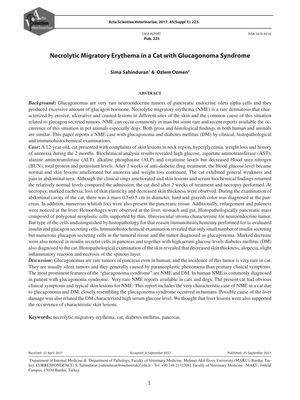Necrolytic Migratory Erythema in a Cat with Glucagonoma Syndrome
June 2017
in “
Acta Scientiae Veterinariae
”

TLDR A cat with a rare pancreatic tumor and diabetes died despite treatment, showing similar symptoms to a human condition.
The document describes a case of Necrolytic Migratory Erythema (NME) in a 12-year-old cat with concurrent glucagonoma and diabetes mellitus (DM). The cat presented with skin lesions, hyperglycemia, weight loss, and anorexia. Despite treatment that normalized blood glucose levels and improved skin lesions, the cat died after two weeks. Necropsy revealed a small pancreatic tumor, liver abnormalities, and marked cachexia. Histopathological and immunohistochemical examinations confirmed the presence of a glucagon-secreting neuroendocrine tumor (glucagonoma) and a decrease in insulin-secreting cells, leading to the diagnosis of DM. The skin examination showed decreased thickness, alopecia, and necrosis. This case mirrors the glucagonoma syndrome seen in humans, which is characterized by NME and DM, and suggests that the liver damage observed may have been related to the high serum glucose levels associated with DM. Glucagonomas are rare in cats, making this a particularly noteworthy case.


